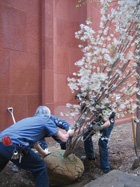Green Streets
It’s a fair bet that the Manhates Indians—the original Village “locals”—would be awestruck if they walked along West Fourth Street in 2010. They’d find tall edifices, honking cars, and a stream of people inexplicably consumed with their BlackBerries and iPhones. But at the corner of West Fourth and Washington Square East, they’d also find a garden that just might offer a little sense of home and comfort amidst the chaos of the modern world.Situated between Bobst Library and Shimkin Hall, NYU’s Native Woodland Garden boasts 39 species of native plants, including assorted ferns, sedge, wild ginger, and sarsaparilla. The 2,200-square-foot patch offers a small, rare glimpse of the landscape that the Manhates might have known in 1609. In the centuries since, these species have become so foreign here that some seeds had to be imported from Ohio, Maryland, and Pennsylvania. The new plot is an ecological anomaly on an island once marked with valleys, grasslands, oak forests, salt marshes, wetlands, springs, ponds, and streams.
The Native Woodland Garden is the first to be planted as part of the Mannahatta Project, an effort by the Wildlife Conservation Society to remember and re-create the natural history of New York City. A legacy gift of NYU’s Class of 2008, the garden was designed by American Horticultural Society award-winner Darrel Morrison and serves as a reminder of how easily native flora thrive in contrast to exotic plants, which need to be constantly watered and pumped with chemicals. “It’ll take two years to get it established and then, hopefully, we just leave it alone,” says head gardener George Reis (CAS ’10), who aims to make NYU “a horticulturally significant place.”

Reis has been working with Cecil Scheib, director of energy and sustainability, to enhance NYU’s landscape—from planters around Pless Hall bursting with fresh vegetables, which are free to the public, to the tulip garden at Coles Sports Center, which inspires spontaneous photos all spring. “I’ve found the public takes it personally,” says Reis, who often fields questions and suggestions from passersby. And unlike schools with sprawling, bucolic campuses, NYU’s green patches are under an unusual microscope—constant foot traffic means that far more people will see them in a given year than see the New York Botanical Garden. As Reis says: “Any garden that we do at NYU is a public garden.”
—Jason Hollander








